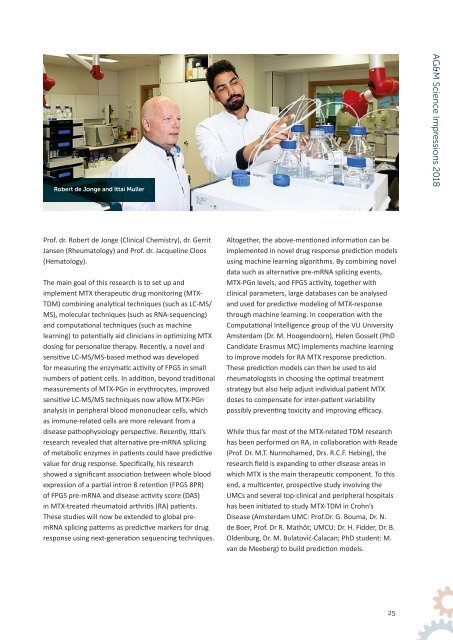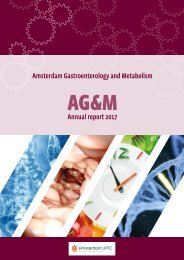AG&M annual report 2018
Create successful ePaper yourself
Turn your PDF publications into a flip-book with our unique Google optimized e-Paper software.
Robert de Jonge and Ittai Muller<br />
AG&M Science Impressions <strong>2018</strong><br />
Prof. dr. Robert de Jonge (Clinical Chemistry), dr. Gerrit<br />
Jansen (Rheumatology) and Prof. dr. Jacqueline Cloos<br />
(Hematology).<br />
The main goal of this research is to set up and<br />
implement MTX therapeutic drug monitoring (MTX-<br />
TDM) combining analytical techniques (such as LC-MS/<br />
MS), molecular techniques (such as RNA-sequencing)<br />
and computational techniques (such as machine<br />
learning) to potentially aid clinicians in optimizing MTX<br />
dosing for personalize therapy. Recently, a novel and<br />
sensitive LC-MS/MS-based method was developed<br />
for measuring the enzymatic activity of FPGS in small<br />
numbers of patient cells. In addition, beyond traditional<br />
measurements of MTX-PGn in erythrocytes, improved<br />
sensitive LC-MS/MS techniques now allow MTX-PGn<br />
analysis in peripheral blood mononuclear cells, which<br />
as immune-related cells are more relevant from a<br />
disease pathophysiology perspective. Recently, Ittai’s<br />
research revealed that alternative pre-mRNA splicing<br />
of metabolic enzymes in patients could have predictive<br />
value for drug response. Specifically, his research<br />
showed a significant association between whole blood<br />
expression of a partial intron 8 retention (FPGS 8PR)<br />
of FPGS pre-mRNA and disease activity score (DAS)<br />
in MTX-treated rheumatoid arthritis (RA) patients.<br />
These studies will now be extended to global premRNA<br />
splicing patterns as predictive markers for drug<br />
response using next-generation sequencing techniques.<br />
Altogether, the above-mentioned information can be<br />
implemented in novel drug response prediction models<br />
using machine learning algorithms. By combining novel<br />
data such as alternative pre-mRNA splicing events,<br />
MTX-PGn levels, and FPGS activity, together with<br />
clinical parameters, large databases can be analysed<br />
and used for predictive modeling of MTX-response<br />
through machine learning. In cooperation with the<br />
Computational Intelligence group of the VU University<br />
Amsterdam (Dr. M. Hoogendoorn), Helen Gosselt (PhD<br />
Candidate Erasmus MC) implements machine learning<br />
to improve models for RA MTX response prediction.<br />
These prediction models can then be used to aid<br />
rheumatologists in choosing the optimal treatment<br />
strategy but also help adjust individual patient MTX<br />
doses to compensate for inter-patient variability<br />
possibly preventing toxicity and improving efficacy.<br />
While thus far most of the MTX-related TDM research<br />
has been performed on RA, in collaboration with Reade<br />
(Prof. Dr. M.T. Nurmohamed, Drs. R.C.F. Hebing), the<br />
research field is expanding to other disease areas in<br />
which MTX is the main therapeutic component. To this<br />
end, a multicenter, prospective study involving the<br />
UMCs and several top-clinical and peripheral hospitals<br />
has been initiated to study MTX-TDM in Crohn’s<br />
Disease (Amsterdam UMC: Prof.Dr. G. Bouma, Dr. N.<br />
de Boer, Prof. Dr R. Mathôt; UMCU: Dr. H. Fidder, Dr. B.<br />
Oldenburg, Dr. M. Bulatović-Ćalacan; PhD student: M.<br />
van de Meeberg) to build prediction models.<br />
25



